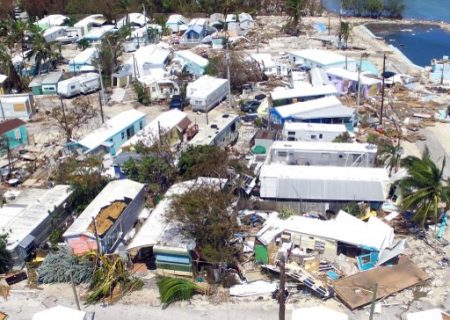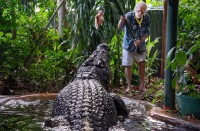
by Leila Macor
Agence France Presse
ISLAMORADA, United States (AFP) — Residents of the storm-ravaged Florida Keys discovered scenes of desolation as they returned home Tuesday as officials launched a massive operation to restore electricity to millions of people still without power in three southern US states.
Shattered mobile homes, grounded sailboats and jumbled mounds of debris greeted Keys residents as police began lifting roadblocks to the islands following the passage of Hurricane Irma.
“We don’t have much left,” Patty Purdo, a 55-year-old waitress, said as she surveyed her home in the wreckage of the Seabreeze trailer park on the island of Islamorada.
European leaders visited the storm-ravaged Caribbean meanwhile amid criticism over relief efforts and the White House announced that President Donald Trump and his wife, Melania, would visit Florida on Thursday.
Brock Long, director of the Federal Emergency Management Agency (FEMA), said Irma caused major damage in the Keys, a 120-mile (195-kilometer) string of islands off Florida’s southern coast known for boating, scuba diving and fishing.
There have been no reports of fatalities in the Keys since Irma made landfall there as a Category Four hurricane, but the islands had been all-but cut off since the storm struck early Sunday.
“You just pray that everybody is alive,” Governor Rick Scott said of the Keys residents — estimated to number several thousand — who ignored orders to evacuate.
Despite forecasts of catastrophic damage, most of the Sunshine State appeared to have escaped the worst as Irma raked the western coast of Florida, eventually being downgraded to a tropical storm.
The Keys stands as the major exception.
“Basically every house in the Keys has been impacted some way or another,” FEMA chief Long told a news conference, estimating that 25 percent of houses on the archipelago have been destroyed, and 60 percent damaged.
No power, no water
“Most areas are still without power and water. Cell service is spotty. And most gas stations are still closed,” Monroe County authorities said in a Facebook post.
“We’ve got to get people their power back down there,” Governor Scott said. “We’ve got to get the sewage system back working.”
With over 15 million people without electricity in Florida, one million in neighboring Georgia and 20,000 in South Carolina, authorities launched a massive effort to restore power.
“We’re having over 30,000 individuals from out of state helping us get our power back on,” Governor Scott told reporters while touring flood damage in the northeast city of Jacksonville.
Scott said the authorities had rescued more than 300 people in Jacksonville, a city of 880,000 hit by flooding on Monday.
As much of the state struggled with power outages and gas shortages, Walt Disney World in Orlando reopened Tuesday after closing for the hurricane, as did Disney’s other theme parks — Epcot, Animal Kingdom and Hollywood Studios.
Katherine Tenea, who travelled to Disney World from Tampa, Florida, with a friend said she had been “cooped up in the house for three days” and looked forward to being able to “stretch out and hang out.”
Before reaching the US Irma tore through a string of Caribbean islands, going from tiny Barbuda on Wednesday to the tropical paradises of Saint Barthelemy and Saint Martin, the US and British Virgin Islands, Puerto Rico, the Dominican Republic, Haiti and the Turks and Caicos Islands.
Irma’s overall death toll is estimated to be at least 40 after Cuba reported that 10 people had been killed there over the weekend.
Macron, Johnson visit Caribbean
French President Macron and Britain’s Foreign Secretary Johnson were visiting their hurricane-hit Caribbean territories on Tuesday.
Dutch King Willem-Alexander is already in the region, which bore the brunt of one of the most powerful storms on record and where residents and holidaymakers are becoming increasingly desperate.
“Even from the plane I saw something I have never seen before,” the Dutch king told the NOS public newscaster. “I have seen proper war as well as natural disasters before, but I’ve never seen anything like this.”
Macron’s plane touched down in St Martin as anger grew over looting and lawlessness in the French-Dutch territory after Irma.
“He needs to come to look around, so that he realizes the horror here,” local resident Peggy Brun told AFP.
The French, British and Dutch governments have faced criticism for failing to anticipate the disaster with an editorial in The Telegraph newspaper calling the response “appallingly slow.”
Speaking in Guadeloupe, Macron insisted French authorities were as well prepared as they could have been.
“Now is not the time for controversy,” he said. “Returning life to normal is the absolute priority.”
Johnson was visiting the British Virgin Islands and Anguilla, where Britain has sent nearly 1,000 military personnel to help both with security, and what he described as an “unprecedented” relief effort.
“The UK is going to be with you for the long term,” Johnson said in a video message to island residents.
British junior foreign minister Alan Duncan told parliament that 100 high-risk prisoners escaped in the territory during Hurricane Irma, which threatened a “complete breakdown of law and order.” He did not disclose how many were still at large.
© Agence France-Presse








